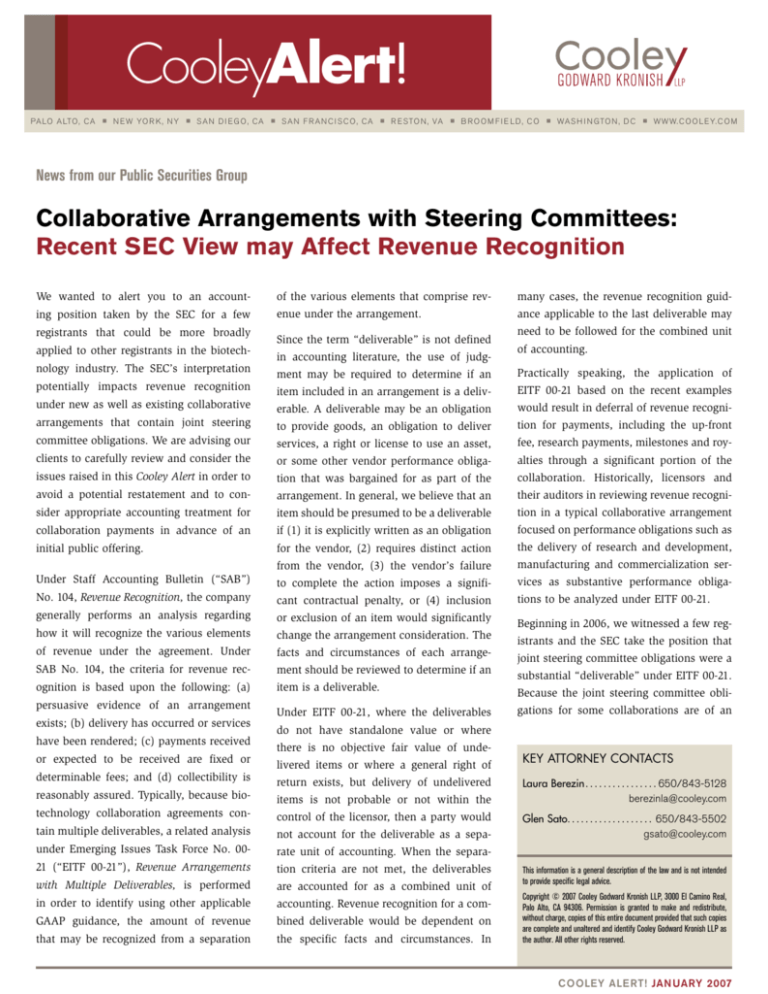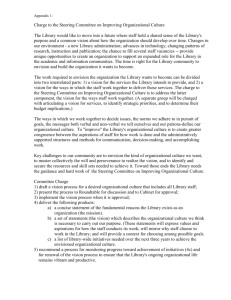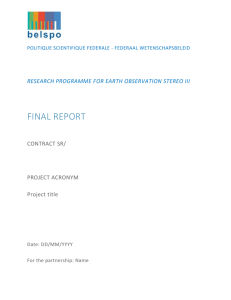
CooleyAlert!
Pa lo A lto , C A
■
N E W YO R K , N Y
■
San D i eg o, CA
■
S a n F r a nc i sc o , CA
■
R esto n , VA
■
B r o o m f i e ld, C O
■
WA S H I N GTO N , D C
■
www. c o o ley. c o m
News from our Public Securities Group
Collaborative Arrangements with Steering Committees:
Recent SEC View may Affect Revenue Recognition
We wanted to alert you to an account-
of the various elements that comprise rev-
many cases, the revenue recognition guid-
ing position taken by the SEC for a few
enue under the arrangement.
ance applicable to the last deliverable may
registrants that could be more broadly
applied to other registrants in the biotechnology industry. The SEC’s interpretation
potentially impacts revenue recognition
under new as well as existing collaborative
Since the term “deliverable” is not defined
in accounting literature, the use of judg-
need to be followed for the combined unit
of accounting.
ment may be required to determine if an
Practically speaking, the application of
item included in an arrangement is a deliv-
EITF 00-21 based on the recent examples
erable. A deliverable may be an obligation
would result in deferral of revenue recogni-
arrangements that contain joint steering
to provide goods, an obligation to deliver
tion for payments, including the up-front
committee obligations. We are advising our
services, a right or license to use an asset,
fee, research payments, milestones and roy-
clients to carefully review and consider the
or some other vendor performance obliga-
alties through a significant portion of the
issues raised in this Cooley Alert in order to
tion that was bargained for as part of the
collaboration. Historically, licensors and
avoid a potential restatement and to con-
arrangement. In general, we believe that an
their auditors in reviewing revenue recogni-
sider appropriate accounting treatment for
item should be presumed to be a deliverable
tion in a typical collaborative arrangement
collaboration payments in advance of an
if (1) it is explicitly written as an obligation
focused on performance obligations such as
initial public offering.
for the vendor, (2) requires distinct action
the delivery of research and development,
from the vendor, (3) the vendor’s failure
manufacturing and commercialization ser-
Under Staff Accounting Bulletin (“SAB”)
to complete the action imposes a signifi-
vices as substantive performance obliga-
No. 104, Revenue Recognition, the company
cant contractual penalty, or (4) inclusion
tions to be analyzed under EITF 00-21.
generally performs an analysis regarding
or exclusion of an item would significantly
how it will recognize the various elements
change the arrangement consideration. The
of revenue under the agreement. Under
facts and circumstances of each arrange-
SAB No. 104, the criteria for revenue rec-
ment should be reviewed to determine if an
ognition is based upon the following: (a)
item is a deliverable.
persuasive evidence of an arrangement
exists; (b) delivery has occurred or services
have been rendered; (c) payments received
or expected to be received are fixed or
determinable fees; and (d) collectibility is
reasonably assured. Typically, because bio-
Under EITF 00-21, where the deliverables
Beginning in 2006, we witnessed a few registrants and the SEC take the position that
joint steering committee obligations were a
substantial “deliverable” under EITF 00-21.
Because the joint steering committee obligations for some collaborations are of an
do not have standalone value or where
there is no objective fair value of undelivered items or where a general right of
return exists, but delivery of undelivered
items is not probable or not within the
technology collaboration agreements con-
control of the licensor, then a party would
tain multiple deliverables, a related analysis
not account for the deliverable as a sepa-
under Emerging Issues Task Force No. 00-
rate unit of accounting. When the separa-
21 (“EITF 00-21”), Revenue Arrangements
tion criteria are not met, the deliverables
with Multiple Deliverables, is performed
are accounted for as a combined unit of
in order to identify using other applicable
accounting. Revenue recognition for a com-
GAAP guidance, the amount of revenue
bined deliverable would be dependent on
that may be recognized from a separation
the specific facts and circumstances. In
Key Attorney Contacts
Laura Berezin. . . . . . . . . . . . . . . . 650/843-5128
berezinla@cooley.com
Glen Sato. . . . . . . . . . . . . . . . . . . . 650/843-5502
gsato@cooley.com
This information is a general description of the law and is not intended
to provide specific legal advice.
Copyright © 2007 Cooley Godward Kronish LLP, 3000 El Camino Real,
Palo Alto, CA 94306. Permission is granted to make and redistribute,
without charge, copies of this entire document provided that such copies
are complete and unaltered and identify Cooley Godward Kronish LLP as
the author. All other rights reserved.
Cooley Ale rt! Jan uary 2007
uncertain term, these registrants concluded
collaborative arrangements such as the up-
The underlying issue raised in the SEC’s
that the term of the obligation could not be
front fee, milestones and maintenance fees
review of the Curis financial statements was
reasonably estimated. Because the revenue
would no longer be recognized ratably and
that the joint steering committee (“JSC”)
recognition for a combined unit of account-
even royalties would be accounted for as
governing the collaboration did not have
ing typically follows the accounting appli-
deferred revenue until the steering commit-
a defined termination date. Curis identi-
cable to the final deliverable, no revenue
tee obligations were terminated or other-
fied the JSC as an ongoing substantive
will be recognized by these registrants until
wise qualified as separate units of account-
obligation. As a result, without a fixed ter-
the term of the joint steering committee
ing under the EITF 00-21 analysis. We are
mination date or the basis for stating that
obligation can be estimated. For these reg-
working closely with accounting firms and
participation was perfunctory or inconse-
istrants, the characterization of what has
discussing this with the SEC in an effort to
quential, the JSC became one of a number
traditionally been viewed as a governance
obtain clearer guidance in drafting agree-
of obligations without stand-alone value or
commitment created significant issues in
ments to address this issue.
separate fair value. In this situation, in the
revenue recognition under EITF 00-21.
Generally, we believe that most collaborative agreements have up-front fees, license
maintenance fees and milestones recognized ratably as revenue over an identified
period of performance under the agreement. Milestones and R&D funding, where
matched to performance of obligations and
related costs incurred by the licensor, are
often recognized when achieved, in the
case of milestones, or over the performance
period in the case of R&D payments. The
treatment under EITF 00-21 where the joint
steering committee is considered a separate,
undelivered deliverable would result in
deferral of recognition of revenue of many
of these payments, including not only the
up-front fees but also milestones, research
payments, royalties and product revenues,
until the separate units of accounting can
be identified or until the term of the obligation can be identified. Deferral of recognition of revenue would be significantly different from the traditional position clients
have taken that (a) ratable recognition on
a straight line basis such as patent term, as
the outward end of the life the product, is
appropriate and straight-line amortization
over that period of time is acceptable; or
absence of standalone value or an objective
Background
fair value, the JSC could not be viewed as
In the first quarter of 2006, as part of an
services and license. As a result, under
ordinary course review of the 2005 Annual
EITF 00-21 Curis was previously incorrect
Report on Form 10-K of Curis, Inc., guidance from the SEC raised significant issues
regarding a company’s ability to recognize
revenue in collaborations in which our
clients are typically performing work or
undertaking obligations for some period of
time. Curis had to restate financial statements for 2.75 years as a result of revisiting
revenue recognition following the EITF 0021 analysis. (Note: Cooley represented Curis
in the negotiation of the collaboration and
license agreement discussed above.)
The Curis transaction involved a collaboration and license agreement in which Curis
licensed certain rights to a small molecule
against a specified target, two years of
research for development small molecules
and antibodies against the target. Curis
retained a co-development right in a specified indication in the U.S. The agreement
provided for a joint steering committee
composed of representatives of both parties to oversee the parties’ collaborative
a separate unit of accounting from the R&D
in recognizing revenue from the up-front
and maintenance fees over a period prior to
the time in which the participation on the
JSC is expected to become inconsequential
or perfunctory.
The Curis case is a significant concern as
this is the first instance we are aware of in
which a steering committee obligation with
no definable term was considered significant. We’ve recently experienced this firsthand with another client that resulted in
months of delay in discussing prospective
revenue recognition under a recent collaboration agreement, and ultimately resulted
in our client having the prospect of either
(a) deferring revenue from up-front fees,
royalties or profits for research and manufacturing services for an indefinite period,
or (b) having to amend the agreement with
its partner to truncate commitments such
as JSC participation prior to commercialization in order to recognize revenue from
those sources.
development and commercialization activi-
We believe that this issue will be most
ties. As is commonly the case in this sort
significant for parties who have some co-
of collaborative arrangement, the com-
development responsibilities (or conduct
mittee was intended to function not only
separate development in different indica-
revenue over time.
as a governance mechanism but also as a
tions but have obligations to share data or
means to provide each party with informa-
the like). Nevertheless other arrangements
The implication of the recent experience
tion regarding the other party’s efforts on
in which there is research or develop-
with the SEC is that payments under the
an ongoing basis.
ment being conducted or where there is a
(b) some proportionate performance based
on a ratio of the services delivered to the
total level of effort anticipated over the
collaboration could support recognition of
Cooley Ale rt! Jan uary 2007
continuing obligation to supply will call
consider an amendment terminating at
into question the revenue recognition for
some specified time in the future those
payments received under the collaboration.
substantive obligations.
Obviously, the analysis will be fact specific
but it is important to note that some of the
obligations that have historically been considered perfunctory or non-substantive may
not be viewed in that light for accounting
analysis.
More details regarding this issue and
the treatment elected by Curis may be
found in the following SEC comment
letter
and
response
regarding
Curis:
www.sec.gov/Archives/edgar/data/1108205
/000119312506060074/filename1.htm. n
This issue is currently under review and
discussion at the SEC. We do not expect
further guidance until much later this year
on this topic. As a result, we are strongly
encouraging our clients to consider the
implications of this uncertainty in the
preparation and review of their collaboration agreements.
What to do now
u
For those who are drafting agreements
or who entered into collaboration agreements this past year, review closely and
reach agreement with your auditors
on the appropriate revenue recognition
under the collaborative agreement. If
you are currently drafting a collaboration agreement, consider a sunset provision for the steering committee (and
subcommittees), the right to opt out of
the steering committee after some specified time, or the clarification of whether
there are any significant penalties for not
participating in joint steering committee
activities.
u
Review any current significant collaboration agreements to identify continuing
substantive obligations (in particular
but not limited to joint steering committee participation). It is likely that most
of larger collaboration agreements have
JSC’s with no specific termination or end
date. Further note that significant obligations beyond JSC participation, such as
manufacturing or supply commitments,
should also be considered separately
in the assessment. If you believe that
your continuing obligations may present issues in recognizing revenue, then
Cooley Ale rt! Jan uary 2007








